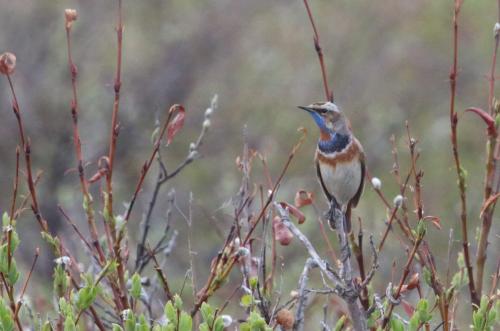Among the researchers working at Toolik and the group that shares our lab space is Team Bird from UC Davis. I had the fantastic opportunity to spend a day out in the field with Jesse Krause, Helen Chmura and Mikaela McGuigan and help locate nesting White Crowned Sparrows and Lapland Longspurs. This is a challenging proposition, as there is lots of open tundra for these ground nesters to lay eggs. Over the past few years however, Team Bird has developed a good strategy for finding nests. Subtle variations in habitat helps increase the odds, but ultimately is comes down to covering a lot of ground. We walked about 3-5 meters apart though the Dwarf Birch and Willow and watched carefully for a bird to run off or fly. We also listened intently for singing males and scanned the vegetation for activity. Playback recordings of singing males stirred up interest on a few occasions.
 This white crowned sparrow just recently hatched
This white crowned sparrow just recently hatched
After and hour or so of no luck, we soon hit the jack pot of nest finding, locating 6 active nests over the course of the afternoon. Most of these had about 5 eggs, but one had 4 recently born, featherless chicks. Still blind, they opened their wide gapes upon hearing us, expecting a meal. After documenting the nest and developmental stage of the hatchlings, we quickly moved off.
 The nest of a Northern Harrier, a ground nesting hawk of the open tundra.
The nest of a Northern Harrier, a ground nesting hawk of the open tundra.
Part of Team Bird's research involves the relationship between the timing of nesting and reproductive success. With climate change, the phenology of plant greening, and insect activity is changing. This may impact food availability, nesting habitat, and perhaps nesting success. When these hungry nestlings hatch, it is critical that food in the form of insects, is available. The insect hatch of flies, mosquitoes, spiders, butterflies, beetles, and others, depends largely on temperature. To understand these complex ecological interactions, other groups are actively measuring plant greening, and insect activity in the immediate vicinity of the nesting areas.
 The timing of nesting must be in sync with plant greening and insect availability. The cotton grass is now in bloom.
The timing of nesting must be in sync with plant greening and insect availability. The cotton grass is now in bloom.
I also had the opportunity to go search for the elusive Bluethroat with Toolik naturalist, Seth Beaudreault. This is a Eurasian species that may be expanding its range into Alaska from Siberia. In North America, They are found only along the North Slope of the Brooks range. To locate the bird, Seth used his knowledge of the wide range of vocalizations the Bluethroats make. These birds are adept at mimicking other bird's songs. Seth recognized similarities to White Crowned Sparrows, Golden Plovers, Yellow Warbler and even a duck call. Along with the vivid color pattern of it's throat, I guess this bird's talent for attracting a mate is karaoke! Seth does the daily naturalist journal for the Environmental Data Center at Toolik. This is a great source of information related to what is happening ecologically in the area. In the spring, Seth monitors bird migration into the area with daily point counts. This information, along with mammal sightings like Grizzly, Wolf, Caribou, are also posted. I found it to be a great resource for classroom teachers to use with students to keep abreast of the daily change that comes with the seasons. http://toolik.alaska.edu/edc/journal/index.php
 The Bluethroat is a spectacular Eurasian species, In North America, it can only be seen on the North slope and west coast of Alaska.
The Bluethroat is a spectacular Eurasian species, In North America, it can only be seen on the North slope and west coast of Alaska.
Teachers should check this out. Something like this could be a great class or individual project for any school. I am still working on the idea for my school, but started to document the phenology of springtime with students using Google Docs to start a long term database of ecological events in my area. https://docs.google.com/a/aspenk12.net/spreadsheet/ccc?key=0Au53MhEE53k1dDNXbTlTRHRoN3BEZEtwU2Z6MUdiY0E&usp=drive_web#gid=0
Environmental Data Center Team. 2014. Toolik naturalist' s journal. Toolik Field Station, Institute of Arctic Biology, University of Alaska Fairbanks, Fairbanks, AK 99775.


Comments